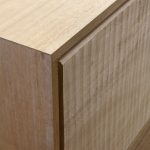We may receive a commission when you use our affiliate links. However, this does not impact our recommendations.
 A couple months back I stumbled onto a bundle of harness leather scraps at a flea market and snapped it up. I was working on a new six-drawer sideboard and it gave me a chance to try out an idea that I had years ago for a shop-made drawer pull. I figured making the pulls wouldn’t be difficult, and it wasn’t. The problem to solve was how to attach them.
A couple months back I stumbled onto a bundle of harness leather scraps at a flea market and snapped it up. I was working on a new six-drawer sideboard and it gave me a chance to try out an idea that I had years ago for a shop-made drawer pull. I figured making the pulls wouldn’t be difficult, and it wasn’t. The problem to solve was how to attach them.
The pulls are simply the harness leather tightly wrapped around a 5/16″ wood dowel. To make the pulls I decided to start with a couple “blanks” that I’d later cut to final size. Because the harness leather is so stiff, I first soaked it in water to make it more pliable. I then clamped the wet leather between two boards with the dowel in place with one board set back immediately behind the dowel to form the round shape of the front of the pull. I left the blanks in the clamps overnight to dry and set the basic shape. Once dry, the blanks went back in the clamps, this time with a generous application of Titebond wood glue to permanently form the shape. Again, I left the blanks to dry overnight.
I had been ruminating over the attachment question. I knew I wanted to mount the pulls centered on the drawer fronts. A slot would have to be cut in the front for the leather to slip into. The slot was made easily enough using a router and 1/4″ diameter bit. Still, the question was how to fasten the pulls. I rejected a couple options as problematic before hitting on the idea of simply using pocket screws. It worked perfectly. And because these drawer fronts are screwed on to a full drawer box, the drawer-box front covers the pocket-screw holes and the slot.
Once I determined how wide each pull would be, I carefully cut the blanks to length on the table saw. I used the slot miter gauge and a gauge block clamped to the saw fence to keep the lengths consistent. I also placed a piece of wood over the blank to help hold it down while making the cut. I was being cautious because I had never cut this material before. It worked well; the only problem was the foul smell of the leather as it was cut. After cutting them to length, I cut each pull to a given width using a miter saw. Again, I covered the pull with a piece of wood to act as a hold-down and keep my hand a safe distance from the blade.
The cabinet is essentially done now and it looks good. One last thing I may do to the pull is use a black or brown permanent marker to color the edges of the leather and the exposed dowel ends. The pulls work quite well. The glued harness leather makes them rigid and the dowel diameter combined with the leather provides a good grip without looking too big.. I think over time the leather will take on a nice darker brown patina. And I have no doubt I’ll make more of these in the future. Shop made pulls add yet another strong element of a custom made piece of furniture.
Here are some supplies and tools we find essential in our everyday work around the shop. We may receive a commission from sales referred by our links; however, we have carefully selected these products for their usefulness and quality.










I know nothing about cow skin? is there better kinds of leather than others and where do you get decent stuff? What do you look for?
These pulls seem like they would dry out and fall apart in short order? Like I said I have no experiance with cow skins.
That idea is definitely a keeper.
Thanks Steve!
Hit the leather up with some Neatsfoot oil so it doesn’t dry out. This is what us olde time hockey goalies used to use on our leather leg pads and gloves (think Gump Worsely) to keep them pliable and resilient. And develop a nice dark brown patina.
Wow, that’s a great idea. I’m thinking Brass rod might be a nice touch in place of the wood dowel. Or stainless steel and black leather…
Thanks for sharing that one Steve!
That is a really cool idea.
Thanks for the idea, Steve. I love the look and the simplicity of the pull.
Will you be able to unscrew the drawer front to service the pull if it’s needed? An alternative to using permanent marker might be some brown leather polish – or a quick dab with wood stain.